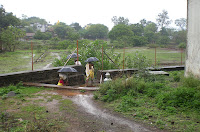
As I entered the Primary Health Center (PHC) in Velhe, about 70 kms from Pune city, the nurse asked me, “Will the doctor be in today?” As it was, the doctor arrived on the next state transportation bus from Pune - I can only surmise from her question, that he attended the PHC only irregularly.
As I spoke with him, it became clear that he, with a family to raise, finds it impossible to stay in a remote village where staff quarters are in a state of disrepair – 6 hours of load-shedding a day and no water in their taps – and water needs to be filled from a hand-pump outside the building. The state of their working environment is not much better – the PHC has been under renovation for two months now (and work is at a stand-still at the present time) with no make-shift space provided for health-workers to function in; the PHC has no water, and water at the near-by rural hospital (RH) also comes from the hand-pump. Ironically, the PHC was envisaged in the Indian healthcare system as the most important facility through which people in far-flung villages would be provided outreach healthcare services.

If the clinics and doctors’ residences were provided essential infrastructure such as water and electricity, it would go a long way toward ensuring that people are provided their right to a functioning primary health care system in their villages – doctors would be much more likely to stay on site, and serve at the PHC regularly.


No comments:
Post a Comment